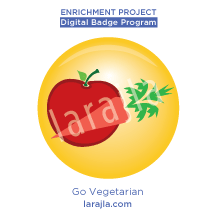 Do you know there are a variety of ways to “be vegetarian”? Let’s explore how different people choose to “go vegetarian.” You might even decide to incorporate this into your lifestyle.
Do you know there are a variety of ways to “be vegetarian”? Let’s explore how different people choose to “go vegetarian.” You might even decide to incorporate this into your lifestyle.
Steps
1. Types of vegetarian.
Explore the different types of vegetarianism. A few are listed below. Which are you
most likely to try?
- Pescatarian
- Flexitarian
- Vegetarian (ovo-lacto, lacto or ovo)
- Vegan
- Raw Vegan
- Macrobiotic
- Fruitarians
2. Adjusting your favorites.
Look at your favorite recipes. By following your type above, what items can you replace and still make your favorite recipes? Try one or two and see how they taste. Make sure you write down what you’re changing so you can repeat the recipe. You may find you like the recipe better with your adjustments.
3. Try it twice.
If you didn’t like the recipe with the adjusted ingredients, don’t stop experimenting.
Try adding herbs, spices, seasonings, etc. to change the flavor. Perhaps try a different
way of preparing the recipe to see if that improves the taste.
4. New foods.
Try a few new prepackaged or prepared foods that are per your chosen vegetarian type. Look at the grocery store for foods that are advertised as “vegetarian.” Check the content list before you buy. It might be good for one type of vegetarian, but not another. Don’t forget to try health food stores as well. What new foods do you enjoy?
5. Plant exploration.
Explore the offerings of your local farmers market to see what fruits and vegetables you can get locally. Try grocery stores, specialty markets and health food stores to find new fruits and vegetables that you’d not considered eating before.
6. Ask your friends and family.
You might not realize that some of your friends and family are vegetarians or might know someone who is. Talk to them or find someone local to discuss the reasons they chose to become a vegetarian and what they allow themselves to eat.
7. Vegetarian part time.
Some people are vegetarian part of the time. By limiting themselves to eating meat once or twice a week, they still get the protein but are trying to help the planet by reducing their meat intake. If you feel you can’t stick to a strict vegetarian lifestyle, try this
alternative.
8. Find a partner.
Trying to go vegetarian by yourself can be a challenge. It takes sixty days to change
a habit. Find someone else who is interested in starting a vegetarian lifestyle to share
your experiences and to offer encouragement.
9. Tasting party.
Host a tasting party (or taste test) with friends and family to keep the expense down
by having everyone bring one or two vegetarian dishes and / or fresh produce that they enjoy. Make sure recipes are available for prepared food.
10. A party for all.
Be aware of vegetarian choices the next time you attend a get together where you are expected to bring a dish. Determine how many dishes at the party could be eaten by
vegetarians. You might be shocked by the results!
11. Religions.
Many religions teach vegetarianism. Find out which religions support a vegetarian lifestyle and their beliefs regarding eating.
12. Health reasons.
How does vegetarianism affect your health? Look at both sides of this issue – from the vegetarian and non-vegetarian sides.
13. Animal cruelty.
Often, animal cruelty is a reason for vegetarian lifestyles. Find out about how the meat
you eat gets to your plate and the conditions that exist around the animals.
14. Learn more.
Learn more about vegetarian health and foods. Talk to other vegetarians about their
experiences. Join an online discussion group or blog if you can’t find one locally.
Sites to Explore
- www.goveg.com
- kidshealth.org/parent/nutrition_center/dietary_needs/vegetarianism.html
- www.ted.com/talks/graham_hill_weekday_vegetarian.html
- www.vrg.org
- www.vegetariantimes.com
- www.savvyvegetarian.com
- www.vegsource.com/news/2010/05/ted-talk-you-can-starve-cancer-with-a-healthy-vegan-diet.html
- www.vegancoach.com
Leave a Reply